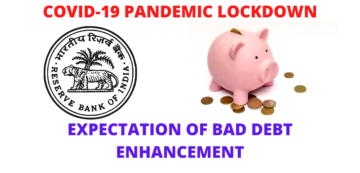Gross NPA of all schedule commercial banks may rise to 12.5% by march 21 from 8.5% in March 2020. This estimation is based on Financial Stability Report released by RBI. Report says that if condition worsens further then the ratio may increase to 14.7%.
Key highlights of the decision:
1. There is a normal functioning of financial market which is only made possible by fiscal, monitory and regulatory interventions
2. Large borrowings of financial sector, global geopolitical tensions and economic losses due to pandemic are the key points for downside of global economy.
3. Action undertaken by the government and financial market regulators to reduce the effect o fCOVID-19 on market helped in maintaining market integrity.
4. We know that bank credit was weakened in the last quarter of 2019-20 which slides down further in the subsequent period with the moderation becoming broad-based across bank groups.
5. The capital to risk-weighted assets ratio (CRAR) of Scheduled Commercial Banks (SCBs) comes down to 14.8% in March 2020 from 15.0% in September 2019. Whereas, gross non-performing asset (GNPA) ratio drops to 8.5% from 9.3% .
6. Macro stress test states that the GNPA ratio of all SCBs may increase from 8.5% to 12.5% by March 2021
7. Total bilateral exposures among entities in the financial system declined marginally during 2019-20.
Indian Financial System seems to be sound despite COVID-19 breakdown
A combination of fiscal, monetary and regulatory interventions by the government has ensured normal functioning of financial sector. Network analysis shows that total bilateral exposure among entities in financial sector drops during 2019-20.
Various monetory policy changes made by RBI during the last quarters is one of the result for market stability. Cuts in repo rates, loan under various schemes with less documentation provides growth to MSMEs. Laons under Guaranteed Emergency Credit Line (GECL) are one of the factor for market boost. However, Indian band loans is expect to increase from the next quarter.
Indian bad loans expected to increase to maximum level
Bad loans in India is expected to increase at its highest level. COVID-19 pandemic lockdown affected business operations and left various people jobless which affects their re-payment of loans. It is expected that NPA may rise 4% points to 12.5% of the total advances by March, 2021.
The main aim of providing moratorium on loan repayment was to provide relief to businessman and individual borrowers. But on 31 August, it is expected that many loan accounts turning NPA which is a bad notice to RBI and the government. The degradation of asset quality further putting pressure on the lenders who are struggling with subdued credit demand.
The rise in bad loans will ultimately reduce the ability of banks to provide credit facilities. In addition, government may have to infuse more funds to state-run banks to maintain stability. Among commercial banks, the gross bad loan ratio of state-owned banks may increase to 15.2% by March, 2021. Whereas, the bad loan ratio of private banks and foreign banks may increase to 7.3% and 3.9%, respectively.
Stress test result shows that 5 banks may fail to meet the minimum capital by the first half of 2021. In addition, 3 banks may fail to meet the minimum CET 1 capital ratio of 5.5% by March, 2021. Public sector banks are now pushed to raise funds from the market instead of being dependent on government for capital infusion. The private bank with lower bad loans have been more successful in raising funds.
Gross NPA of banks may rise to 12.5% by march 21

